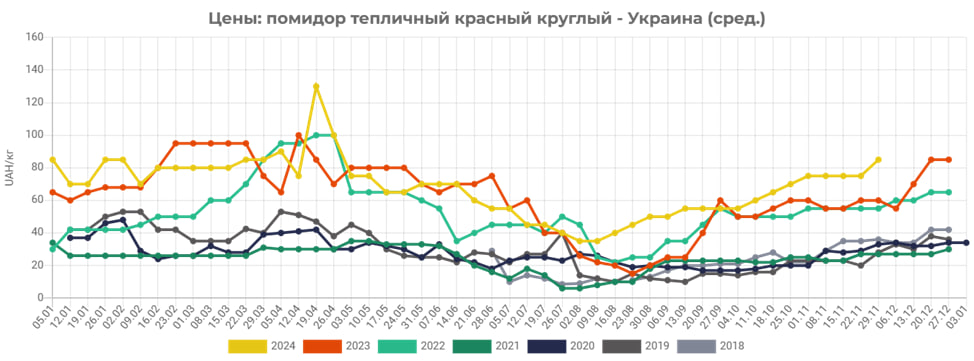
This week, prices for greenhouse tomatoes have increased in Ukraine, according to analysts of the EastFruit project. The reason for the increase in the cost of these products was the seasonal decline in the supply of local tomatoes in greenhouse plants, as most producers have already announced the completion of the current turnover of this crop.
Thus, today tomatoes are on sale at 80-90 UAH/kg ($1.92-2.16/kg), which is on average 13% more expensive than at the end of the previous working week. The newly formed prices for these products remain the highest in the domestic market of Ukraine, at least for the last 7 years!

According to the producers, the vegetable samples at the local stationary plants are currently small, which, in turn, allowed the sellers to raise prices for the available volumes of products. At the same time, traders have not yet been able to compensate for the insufficient supply of local tomatoes with imported products.
It is worth noting that currently the price of greenhouse tomatoes in Ukraine is already on average 49% higher than at the end of November 2023. As for further forecasts, market participants assume that the supply of tomatoes from Turkey will soon increase, and given that the sales season in Ukrainian plants is coming to an end, the main supply of greenhouse vegetables will be imported products.
For more information on the development of the tomato and other fruit and vegetable market in Ukraine, please subscribe to the operational analytical weekly – EastFruit Ukraine Weekly Pro. Detailed information about the product is available here.
Source: https://east-fruit.com/novosti/v-ukraine-opyat-dorozhayut-pomidory/

Moloko Vitchyzny LLC (Sumy region) is completing the construction of a dairy complex for 3,000 heads of cattle in Dubno district, Rivne region, the head of Rivne Regional State Administration Oleksandr Koval said on Facebook.
“For us, the new farm means not only additional budget revenues, but also 85 jobs. We are grateful to the business that, despite the war, is implementing such ambitious projects in Rivne region,” he emphasized.
Moloko Vitchyzny LLC promises to complete the construction of the dairy complex in the near future. In the summer of 2025, they intend to ship the first milk. The planned productivity of the herd is 39 thousand tons of milk per year. Moloko Vitchyzny LLC was registered in 2018 in Sumy region. The company included three dairy farms equipped with modern equipment. The total herd size is 7800 cattle, including 3100 heads of dairy Holstein cows.
According to the Opendatabot resource, the company’s revenue in 2024 amounted to UAH 470.12 million, net profit – UAH 102.9 million, debt – UAH 81.25 million, and assets were estimated at UAH 743.52 million. The farms employed 177 people. The authorized capital was UAH 52.2 million.
The beneficiaries of Moloko Vitchyzny LLC are Volodymyr Zayets (47.25%), Serhiy Zayets (3.32%), Serhiy Chyzhyk (42.44%) and Swiss citizens Wolf Philipp and Wolf Müller von Blumkencron Christian, who own 3.5% of the shares each.
Source: https://interfax.com.ua/

Turkey’s GDP growth rate in the third quarter of 2024 slowed to 2.1 percent in annualized terms after climbing 2.4 percent a quarter earlier, the country’s statistical institute (TurkStat) said. This is the worst performance since the second quarter of 2020, when Turkey recorded a contraction in GDP at the height of the coronavirus pandemic. Analysts surveyed by Trading Economics had on average forecast growth of 2.6% in July-September.
Consumer spending rose 3.1% last quarter. Meanwhile, government spending fell by 0.9%, the fastest pace since the first quarter of 2021, and business investment fell by 0.8%, registering a negative trend for the first time in two years.
Exports rose just 0.8% in July-September, while imports fell 9.6%.
Turkey’s GDP contracted by 0.2% in the third quarter relative to the previous three months. The revised data also showed a 0.2% contraction in April-June, while a 0.1% rebound was previously reported.
Turkey’s economy has not contracted for two consecutive quarters on a quarter-on-quarter basis, which meets the technical definition of a recession, since 2018.
Earlier Experts Club think tank and Maxim Urakin released a video analysis of how the GDPs of countries around the world have changed in recent years, more video analysis is available here – https://youtu.be/w5fF_GYyrIc?si=BsZmIUERHSBJrO_3.
Subscribe to Experts Club’s youtube channel here – https://www.youtube.com/@ExpertsClub

Currently, about 3.4 million children in Ukraine have limited access to water and sanitation, said Munir Mammadzadeh, UNICEF Representative in Ukraine.
“We know that about 3.4 million children have problems with access to water and sanitation, and the problem is especially acute in the frontline regions,” he said in an interview withInterfax-Ukraine.
That is why the supply of drinking water and hygiene kits is one of the key tasks for UNICEF. In addition, the UN Children’s Fund is working with water utilities on large-scale projects to restore infrastructure to make drinking water available. According to Mammadzadeh, even if children are not directly exposed to the risk of hostilities or attacks, the lack of normal life and anxiety also significantly affects their mental health.
UNICEF pays a lot of attention to the psychological problems of children and adolescents in the context of war.
“This is one of the areas where a lot of work is being done, as 1.5 million children in Ukraine today face problems such as depression, insomnia, and anxiety. We also know that during this thousand days, children have spent 2,800 to 4,800 hours in shelters while regular alarms sound – these estimates show the scale of the war’s impact on children: since the beginning of the war, they have spent an average of 4 to 6.5 months in shelters,” Mammadzadeh said.
He noted that a number of programs are already being organized to provide psychological assistance to children in Ukraine. For example, resilience centers in local communities already include mental health components as basic services. UNICEF also cooperates with Ukrainian universities to train good mental health professionals and works with school teachers and psychologists to help them recognize the elements of anxiety in children and provide basic assistance.

Since the beginning of Russia’s full-scale invasion of Ukraine, UNICEF has managed to mobilize more than $1 billion to help young Ukrainians, said Munir Mammadzadeh, head of the UN Children’s Fund (UNICEF) in Ukraine.
“We were in the country before the war, our mandate covered development and humanitarian issues. That is, we were already working and had a presence in the regions, which helped us to launch a full-fledged response to the full-scale war and attract additional resources to help children as much as possible. During this time, we have managed to mobilize more than $1 billion for Ukraine and neighboring countries where Ukrainians have started to move because of the war,” he said in an interview with Interfax-Ukraine.
According to Mammadzadeh, UNICEF’s request for humanitarian aid for Ukraine for this year is $496 million, and 70% of this amount has been funded, which shows the interest of donor countries in supporting Ukraine. He noted that it is often impossible to attract more than 50%.
In addition, in addition to humanitarian aid to the needy, UNICEF also has programmatic activities related to development, recovery and other areas. “We are now clearly distinguishing between what is humanitarian activity – saving lives – and what is part of our development work,” said Mammadzade.
According to him, next year UNICEF plans to reduce the humanitarian request by 20% compared to this year and increase plans and requests for systemic work, i.e. the development component of the mandate, which includes social protection issues.

Ukraine wanted to buy arms from South Korea that would help in confronting the Russian army, but Seoul refused, South Korea’s SBS News reported.
According to the publication, the Ukrainian delegation asked for authorization to purchase Korean weapons, not a free transfer. In particular, Cheongung medium-range surface-to-air missiles.
According to the source, Ukraine asked for non-lethal weapons. In addition to Cheongung interceptor missiles, the Ukrainians were interested in radars – for air defense and anti-artillery. The Ukrainians also requested charges for 155mm artillery shells.
It is likely that Korean defense companies such as LIG Nex1, Hanwha and Hyundai Rotem have received offers from Ukraine to cooperate on arms purchases. But the South Korean Defense Ministry recommended them to refrain from signing contracts. The reason for the refusal is allegedly “a high risk of violating foreign trade laws restricting exports to combat zones”.
As reported, a Ukrainian delegation headed by Defense Minister Rustem Umerov visited Seoul earlier this week.